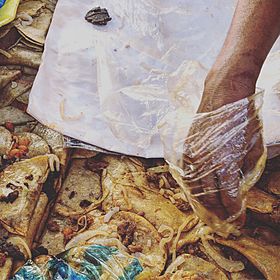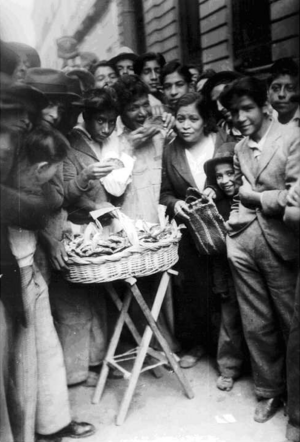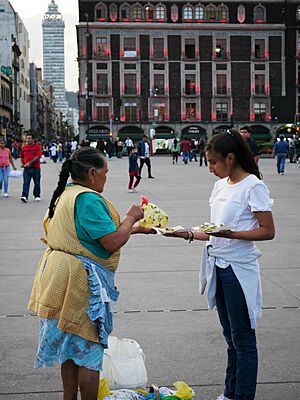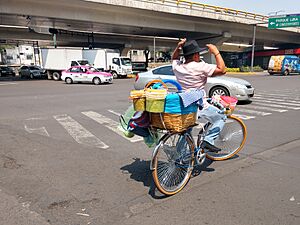Tacos de canasta facts for kids

tacos de canasta in Coyoacán
|
|
| Alternative names | tacos sudados paquitos sudados (in Chiapas) tacos al vapor (Northern Mexico) |
|---|---|
| Type | taco; Mexican antojito |
| Place of origin | Tlaxcala, Mexico |
| Associated national cuisine | Mexican cuisine |
Tacos de canasta are a super popular Mexican food. Their name means 'basket tacos'. They are made of tortillas filled with different tasty stews. Some common fillings are potato (called papa), chicharrón (pork rinds), frijoles (beans), or adobo (a special marinade). After being filled, the tacos are dipped in oil or melted butter.
These delicious tacos first came from San Vicente Xiloxochitla in Tlaxcala, Mexico. But you can find them all over central Mexico, especially in big cities. People often sell them from bicycles on the streets or at small street stalls. The name "basket tacos" comes from the special basket they are kept in. This basket helps keep them warm and fresh!
Tacos de canasta are known as a simple and very cheap snack. They usually cost less than 10 Mexican pesos. They are also very filling and a favorite food for many Mexicans. People traditionally eat them with spicy sauces (like green or red salsa), pickled chilies, or guacamole.
Contents
Where Did Basket Tacos Come From?
Selling tacos from baskets in Mexico City has been happening for a very long time, even before the 1900s. However, the basket tacos we know today started in the 1950s. They came from a town called San Vicente Xiloxochitla. This town is about 10 kilometers from Tlaxcala de Xicohténcatl. It's even known as "the cradle" or "the capital" of the basket taco!
Originally, these "sweaty tacos" (tacos sudados) were a meal eaten after a long day of working in the fields. But over time, people in the town needed new ways to earn money. So, they started making and selling these tacos.
Today, a large number of families in Xiloxochitla (between 50% and 80%) make tacos de canasta. Many of them travel daily to Mexico City to sell their tacos.
How Are Basket Tacos Made?
The most common fillings (called guisos) for basket tacos are four: beans, potato, adobo, and pork rinds. While there are now more types of fillings, these four are considered the "classic" ones. Making these fillings often starts the night before, by cooking the potatoes and beans.
Classic Taco Fillings
- Adobo Stew: This filling uses cooked and shredded beef brisket. It's mixed with salt, onion, and a special sauce made from guajillo chili. Then, it's cooked with beef broth until it becomes thick.
- Chicharrón Stew: For this, onion is cooked first. Then, pressed pork rinds are added. It's mixed with guajillo chili adobo and heated until it gets thick.
- Frijoles Stew: Bayos beans are cooked with salt and onion. Then, they are mashed into a smooth paste. This bean paste is cooked in a pan until it loses extra liquid.
- Potatoes Stew: Potatoes are cooked and mashed. They are mixed with salt, cooked onion, and serrano pepper. Then, milk is added, and the mixture is heated until all the ingredients are well combined and thick.
The Special Basket
The basket used for these tacos is lined with special materials. These include kraft paper, aluminum foil, and a plastic or rubber bag (often blue). To fill the basket, a layer of tacos is placed first. Then, a layer of onion (sometimes with dried chili peppers) is added. Finally, hot lard or adobo sauce is poured over them. This process is repeated until the basket is full.
A medium-sized basket can hold about 100 to 150 tacos. Larger baskets can even hold 200 to 500 tacos! The baskets are covered with cloth blankets. This helps keep the tacos warm and moist for a long time, usually up to 4 to 6 hours.
Basket Taco Traditions
The name "tacos de canasta" comes from the basket used to store and sell them. Every morning, around 7:00 or 8:00 AM, the taqueros (taco vendors) leave Xiloxochitla. They travel by bicycle to nearby towns or by truck to big cities like Mexico City or Puebla. Some vendors even stay in the city during the week and go back home on weekends. You can find basket tacos on the streets from mid-morning (around 10:00 or 11:00 AM) until late afternoon (around 4:00 or 5:00 PM).
Customers usually gather around the vendor's stall and eat their tacos right there, standing up. Many regular customers are workers, college students, and office workers who need a quick breakfast. This tradition has become very popular all over Mexico City.
In 2016, a basket taco vendor from Mexico City became famous. Her name is Marven, but she is better known as Lady Tacos de Canasta. She became well-known for her unique way of advertising her tacos at the Pride parade, shouting: “Tacos! Tacos de canasta! Tacos!”. Later, Marven was featured in a Netflix documentary called Las crónicas del taco (2019). She even won a special award, the James Beard Foundation Award, for her work!
Taco de Canasta Fair
Since 2007, a special event called the Taco Fair has been held every year. It takes place in San Vicente Xiloxochitla on the first Sunday of December. At each fair, a group of people makes more than three thousand basket tacos. These tacos are given away for free in the town square to everyone who visits the event!
Different Kinds of Basket Tacos
Paques Sudados
In Comitán, Chiapas, there's a different version of basket tacos called sudados paquitos. The name "paquitos" might be a changed version of "taquitos" (little tacos). On August 8th, which is the day of Santo Domingo de Guzmán (the town's patron saint), vendors go out with their baskets to sell paquitos all over town. Comitan-style paquitos are usually filled with chorizo, egg, potato, rajas (strips of chili peppers), and refried beans.
See also
 In Spanish: Tacos de canasta para niños
In Spanish: Tacos de canasta para niños




